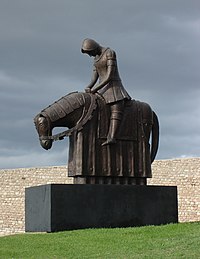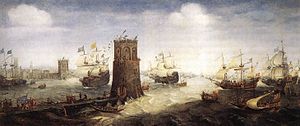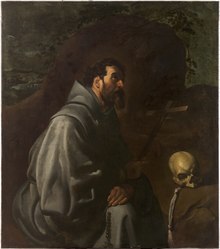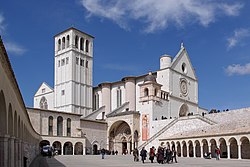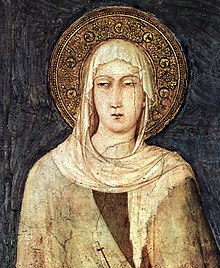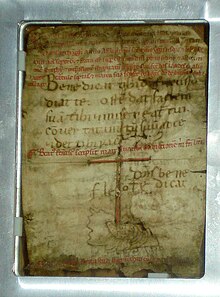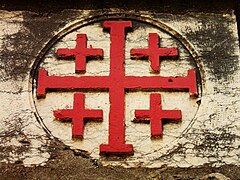Francis of Assisi
Francis of Assisi (in Italian Francesco d'Assisi, born Giovanni di Pietro Bernardone; Assisi, 1181/1182-ibidem, October 3, 1226) was an Umbrian (Italian) saint, deacon, also known as "Father Francis" and founder of the Franciscan Order, of a second order known as the Poor Clare Sisters and a third known as the secular third order, all of which emerged under the authority of the Catholic Church in the Middle Ages. He stands out as one of the great figures of spirituality in the history of Christianity.
From being the son of a rich city merchant in his youth, he went on to live under the strictest poverty and observance of the Gospels. In Egypt he tried unsuccessfully to convert Muslims to Christianity.His religious life was austere and simple, so he encouraged his followers to do the same. Such a way of living was not accepted by some of the new members of the order as it grew; even so, Francisco was not reticent about a reorganization. It is the first known case in history of visible and external stigmatization. He was canonized by the Catholic Church in 1228, and his feast is celebrated on October 4. In Italian he is also known as il poverello d'Assisi, that is, “the poor little Assisi”. His festivities are associated with the end of the rainy season, a phenomenon called Cordonazo de San Francisco.
Historical context
In the 12th century there were fundamental changes in the society of the time: the beginning of the Crusades and the population increase Among other reasons, they influenced the increase in trade and the development of cities. The economy continued to have its fundamental base in the field dominated by the feudal mode of production, but its production surpluses were channeled with greater dynamism than in the Early Middle Ages. Although a clear transition from feudalism to capitalism was not yet taking place and the privileged classes (nobility and clergy) continued to be the dominant ones, as they had been until the Contemporary Age, the bourgeois (artisans, merchants, liberal professionals and businessmen) began to to have possibilities of social ascent, and commerce and banking grew dominated by the constant desire for profit. The Catholic Church, protagonist of that time, was also influenced by the new wealth: there were many critics of some of its ministers who were more concerned with wealth growth and their political relations of convenience.
Because of this, various religious movements arose in rejection of the growing opulence of the ecclesiastical hierarchy at that time, or dedicated themselves to living more in accordance with the postulates of a poor and evangelical life. Some of them thrived outside of the institution and lived in their own way; such movements were condemned to the point of considering them heretics, as in the case of the Cathars who preached, among other things, the rejection of the material world, the sacraments, images and the cross. On the other hand, other organizations —such as those created by Saint Francis of Assisi and Saint Dominic de Guzmán—were born under Catholic authority and their members were known by the generic name of "mendicant monks". This movement exacerbated the practice of the vow of poverty: its members no longer lived off work of the lands like the Cistercian reformed by Saint Bernard of Clairvaux, but they renounced even owning their own property. Thus, the mendicant orders ended up playing a leading role in the life of the Church, by getting the majority of Catholics away from the search for opulence, something that would become in the XIV.
Childhood and youth
Francis of Assisi was born Giovanni. He was the son of Pietro Bernardone dei Moriconi and the Provençal noblewoman Joanna Pica de Bourlémont; he had at least one other brother, named Angelo, his father was a prosperous cloth merchant who was part of the Assisi bourgeoisie and who constantly traveled to France to the local fairs. Among some versions, he was fond of this land for which his father later nicknamed him as Francesco or the Little Frenchman ; It is also likely that the little boy was later known in this way because of his fondness for the French language and the songs of the troubadours.
Francisco received the regular education of the time, in which he learned Latin. As a young man he was characterized by his carefree life: he had no qualms about spending when he was in the company of his friends, on his periodic forays, or giving lavish alms; like any son of a potentate, he had ambitions to be successful.
In its youthful years the city was already embroiled in conflicts to claim its autonomy from the Holy Roman Empire. In 1197 they managed to get rid of the Germanic authority, but from 1201 they became involved in another war against Perugia (Perugia), supported by the exiled nobles of Assisi. At the Battle of Ponte San Giovanni, in November 1202, Francis was taken prisoner and held captive for at least a year.
Since 1198 the pontificate was in conflict with the Empire, and Francis was part of the papal army under the command of Walter of Brienne against the Germans.
According to the stories, it was on a trip to Apulia (1205) while he was marching to fight, when during the night he heard a voice that recommended that he return to Assisi. He did so and returned to the surprise of those who saw him, always jovial but now wrapped in solitary meditations.
He began to show detachment from the earthly. One day when he was in a state of stillness and peace, his friends asked him if he was thinking of getting married, to which he replied: You are right, I plan to get married, and the woman I plan to commit to is so noble, so rich, so good, that none of you saw another like it. Until that moment he himself did not know exactly the path he had to take from then on; it was after reflections and prayers that he knew that the lady he was referring to was poverty.
The culminating point of his transformation occurred when he lived with lepers, whom long before seemed extremely bitter to look at. He later dedicated himself to the reconstruction of the chapel of San Damiano. According to the stories, he did so after seeing the crucifix in this church say to him: Francis, go and repair my church, which is falling into ruins. He then decided to sell the horse and the merchandise from his father in Foligno, he returned to San Damiano with the gain and offered it to the priest, but he refused it.
His father, noticing his son's behavior, was angry in his search, but Francisco was hiding and did not find him. A month later it was he himself who decided to face his father. On the way to his house, the people he met received him badly and, believing him to be a lunatic, threw stones and mud at him.
Francis before the ecclesial authorities
His father reprimanded him severely, so much so that he chained him up and locked him in a dungeon. When the irate father was away on business, the mother released him from his chains. When she returned, it was she who received the reprimands from the master of the house, and went again to look for the boy in San Damiano, but Francisco stood up calmly and reaffirmed that he would face anything for the love of Christ. Pietro Bernardone, more concerned about the loss of his heritage, went to the civil authorities to force him to appear, but the young man refused to do so on the grounds that he no longer belonged to the civil jurisdiction, so the authorities left the case in their hands. of the church.
Francisco submitted to the call of the ecclesial authority. Faced with the requirement to return the money in front of his father and the Bishop of Assisi, named Guido, he not only did so, but also stripped himself of all his clothing before the judges, proclaiming God from that moment as his true Father. At this, the bishop embraced him and wrapped him in his mantle.
Command beginnings
It is not known with certainty how many dilapidated or dilapidated churches he rebuilt; among them, the one that he most esteemed was the chapel of the Porciúncula (“the little part”, so called because it was next to a larger building).
It was there that he received the definitive revelation of his mission, probably on February 24, 1208, when he heard these words from the Gospel: Do not carry a purse, bag, or sandals, nor stop to visit acquaintances ... (Lc., 10). Thus, he changed his desire to rebuild the churches for an austere life and the preaching of the Gospel. After submitting to the ridicule of those who saw him dressed almost in rags, now his message was listened to carefully, and contrary to other reform groups of the time, his was not a message of disqualifications or anathemas.
In a few months his disciples were eleven: Bernardo di Quintavalle, Pedro Catani, Gil, Morico, Bárbaro, Sabatino, Bernardo Vigilante, Juan de San Constanzo, Angelo Tancredo, Felipe and Giovanni de la Capella.
Under the poverty that Francis preached and asked for, the friars did their daily chores caring for lepers, doing humble tasks for monasteries and private homes, and working for farmers. But daily needs made collecting alms inevitable, a task that Francis encouraged with joy for having chosen the path of poverty. He also began the expansion of the evangelical message, and for this he encouraged them to travel two by two.
Audience before the Pope for the approval of the rule
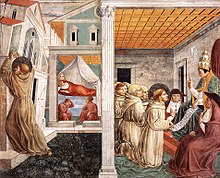
Around April or May 1209, Francis decided to appear before Pope Innocent III, so that he would approve the first rule of the Order. To that end, he and his companions undertook the journey to Rome.
It was under the intervention of Bishop Guido of Assisi that he was able to have an audience with the pope. This and certain cardinals objected to the Franciscan program because of the danger of creating another new organization, due to the anti-clerical movements of the time and the lack of a minimum material base for the order; but under the influence of Cardinal Juan de San Pablo and his support, Francisco was able to have a new audience to consider the approval of his brotherhood of the poor.
The pope finally approved the rule verbally, convinced that the help of a man like Francis would strengthen the image of the Church with his preaching and practice of the Gospel. The content of this first rule is not known.It was around this time (six years after his conversion according to Celano) that he founded, together with Clara of Assisi, the so-called second order.
Rivotorto
On the way back to Assisi, he and his companions settled in a place called Rivotorto, where they consolidated their principles of living in poverty, living among the local peasants and caring for lepers; since then they have called themselves Hermanos Menores or Friars Minor (the founding name of the congregation is Ordo Fratrum Minorum, abbreviated O.F.M.).
After his stay in Rivotorto, he searched for a seat for his order; For this he asked for the help of Bishop Guido, but he did not get a favorable response. It was a Benedictine abbot from Monte Subasio who offered him the chapel of the Porciúncula and an adjacent piece of land (properly the little part, the little portion). Francisco accepted, but not as a gift, rather he paid baskets of fish as rent.
Growth and expansion
Within the spirit of the time of travel to the East, he made an attempt to go to Syria for the spread of the Gospel in the land of the so-called "infidels". This probably happened at the end of the year 1212 and again two years later. Both ventures were frustrated.
Before 1215 the number of friars had increased, not only in Italy but also in southern France and in the kingdoms of Spain. The Franciscans traveled two by two and lived with the common people; In addition, they established hermitages on the outskirts of the cities.
Lateran Council
During the Lateran Council of 1215, the organization acquired a strong legal status; in that year it was decreed that every new order should adopt the Rule of Saint Benedict or that of Saint Augustine. For the Friars Minor there was no need for this, as they had been accepted six years before (although verbally and not officially). At this council Pope Innocent III took the letter Tau as a symbol of conversion and sign of the cross; from then on the poverello was devoted to this symbol.
At that time, Cardinal Hugolino offered him and Domingo de Guzmán the possibility of forming cardinals from the ranks of his orders. Francisco, according to the chronicles of Thomas of Celano, in accordance with his principles, replied: «Your Eminence: my brothers are called minor friars, and they do not try to become majors. Their vocation teaches them to always remain humble. Keep them that way, even against their will, if Your Eminence considers them useful for the Church. And never, I beg you, allow them to become prelates."
Indulgence in the Porziuncola
Under the pontificate of Honorius III in 1216, plenary indulgence was promoted in favor of anyone who visited the church of Santa María de los Ángeles in Porciúncula. Francis obtained that grace from the Pope so that the pilgrimage would take place once a year, but under strong opposition, since few places could enjoy such a high privilege.
Since the year 1217 he organized chapters in which the Friars Minor met to exchange experiences; For the appropriate organization of the territories in which the friars had dispersed, he also organized provinces of evangelization.
Journey to the East
Around the chapter of 1219, the order had its first dissensions regarding the poverty norms dictated by Francis. Some persuaded Cardinal Hugolino to talk to him, so that the order would be led by "wiser" brothers and according to rules like that of Saint Benedict, to which the poverello adhered. he opposed, stressing the way of life of humility and simplicity. The innovation that arose from this meeting was the organization of missions to the so-called "pagan lands".
In 1219 he sailed east, passing through Cyprus, Saint John of Acre, and Damietta in the Nile Delta, where the crusaders were under the command of Duke Leopold VI of Austria. There, Francisco warned them that he had been alerted by God not to carry out any attack; at his words, the soldiers mocked him. The result of the next battle was a disaster for the crusaders.He continued his stay and appreciation for the person grew from him, even some knights laid down their arms to become friars minor .
In front of the sultan of Egypt
He took as his mission the conversion of Muslims. For this he was accompanied by his brother Illuminato to enter those lands; upon meeting the first Saracen soldiers he was beaten, but immediately asked to be brought before the Sultan of Egypt al-Malik al-Kamil.
According to the chronicles of Buenaventura, the poverello, in his desire to convert him to Christianity, invited the Muslim religious ministers to enter with him into a great bonfire (equivalent to an ordeal or test by fire), in order to demonstrate which religion was the true one; the mullahs shied away from the proposal. Francis offered to go in alone and challenged the Sultan that if he escaped unharmed, he would convert to Christianity and incite his people to do so; the prince also rejected that possibility. In the end, his claims were frustrated.In recognition, the sultan of Egypt gave Francis a finely carved ivory horn that would have served as a passport in Muslim lands and is kept in the Basilica of Assisi. Later, Francis obtained permission only to visit Syria and the Holy Land from the Sultan al-Mu'azzam of Damascus, al-Malik's brother.
Crisis and reorganization
The order, during his absence, suffered a crisis: there were dissensions, lack of organization and disagreements with the harsh daily life. The rumor about the death of Francisco in the East gave rise to reforms, among them certain disciplinary measures, fasting and even the institution of a study house in Bologna; many considered these changes contrary to the founder's original idea. Aware of these events, Francis went to Pope Honorius III and begged him to appoint Cardinal Hugolino to reorganize the order.
The new provisions had a new Minister General, Elias Bombarone, and a new rule, that of 1221 (Regla no bullada) which, among other topics, dealt with the novitiate year, the prohibition of wandering and of disobedience to orders contrary to Franciscan principles.
The Third Order
Faced with the increase in vocations and the danger of including people of dubious spiritual vocation, the so-called Venerable Third Order was born, to allow lay men and women to live the Gospel in the footsteps of Francis. It obtained its legal status in 1221 also with the help of Cardinal Hugolino. It is in subsequent writings that its content is rescued, because the original was lost. It consisted of thirteen chapters in which the personal sanctification of the tertiaries, their social life and the organization of the new fraternity were regulated.
Under the influence of this cardinal again, the order reopened the convent of Bologna for study, despite Francis' conviction of the primacy of prayer and the preaching of the Gospels over formal education.
The Ultimate Rule
Under the insistence of ministers of the order, he was forced to draft a new rule, since certain opponents of the then current one considered that it lacked consistency and definition, and that this prevented him from obtaining a definitive approval from the Holy Campus. He again agreed to the demands. To do this, he withdrew twice to the hermitage of Fonte Colombo near Rieti, to draw up a definitive rule under fasting and prayer. On November 29, 1223, with another participation of Cardinal Hugolino, the rule had its final form and was approved by Pope Honorius III.
Christmas in Greccio
Once the work of approving the definitive rule was finished, Francisco decided to return to Umbria. Due to the proximity of Christmas, to which he had a special appreciation, he wanted to celebrate it in a particular way that year of 1223; for this he invited a nobleman from the city of Greccio, named Juan, to celebrate the birth of Jesus Christ on a hill surrounded by trees and full of caves on a piece of land he owned.
He wanted the celebration to be as similar as possible to the nativity of Jesus of Nazareth, and he set up a manger with animals and hay; residents and friars from the surrounding area attended the mass in procession. There the poverello attended as a deacon and preached a sermon. Although it was not the first celebration of this type, it is considered an important religious event, a unique festival. Likewise, it is considered that in that celebration, Saint Francis invented the nativity scenes or nativity scenes, plastic stagings of the birth of Christ.
The stigmata
Francis attended in June 1224 what was his last general chapter of the order. About the beginning of August he decided to make a trip to an isolated place called Monte Alvernia, about 100 miles north of Assisi; he chose for this trip some of his companions: Leon, Angelo, Illuminato, Rufino and Masseo, whom the poverello put in command of the group.
While at the top, he was visited by Count Orlando, who was bringing supplies to the brothers. Francisco asked him to build a cabin for him as a cell, where he later isolated himself. Prayer occupied a central place in the life of Francis; for this he sought the hermitic life, silence and inner solitude. He reinforced his prayers by prostrating himself, fasting, and even gesticulating.
In that place, Fray León witnessed the acts of his solitude: laments for the future of the order and states of ecstasy. Knowing that he was spied on, he decided to go to a more secluded place on a mountain ledge. On the Feast of the Assumption Francisco decided to fast for forty days.
By orders of the povertello, Fray Leon visited him twice to bring him bread and water. According to the accounts collected by León's testimonies, he witnessed the approach and departure of a ball of fire that came down from the sky; Due to this prodigy, Francisco told him that something great was about to happen, he made him open the missal three times to find an answer, and three times he opened it to the story of the Passion of Jesus.
Probably on September 14, 1224, he prayed to receive two graces before dying: to feel the Passion of Jesus, and a long illness with a painful death. After intense prayers, then in a deep trance —according to St. Bonaventure's account— he supposedly appeared before him a seraph surrounded by six angelic wings, and imprinted the signs of the crucifixion on his hands, feet, and side; Later, his brothers saw Francis' stigmata, which he kept for the rest of his life. However, it is said that Francis—like other stigmatized saints—did everything possible to hide them from the view of others because he considered himself unworthy, not of the pain he felt, but of being a bearer of the signs of the Passion of Christ. For this reason, he was from then on with his hands tucked into the sleeves of his habit, and with his feet covered by stockings and shoes.
Death
He returned to Porziuncula accompanied only by León; on his way there were signs of veneration for the stigmatized person, apparently his companion let everyone know about the prodigy. Meanwhile, his health —which had never been entirely good for a long time— was getting worse: the bleeding from his wounds made him suffer constantly. In the summer of 1225 he spent time at San Damiano under the care of those close to him.
It was during this season that he composed the Cantico de las criaturas, which he also made his companions sing. He then headed for Rieti, surrounded by popular enthusiasm for playing it or tearing off a bit of the poorest tunic that he wore, and settled in the bishop's palace. Afterwards he stayed at Fonte Colombo, where he underwent medical treatment, which included cauterizing the area from his ear to the eyebrow of one of his eyes with a hot iron; according to the accounts, Francisco did not feel pain when "chatting" with the fire so that it would not harm him. Another attempt to be treated by renowned doctors was made in Siena, without good result.
He wanted to return to the Porziuncula to spend his last days. He arrived in Assisi and was taken to the bishop's palace and guarded by armed men, since the town was in a state of war. On his bed he wrote his Testament. In his last moments he sang again his Canticle to Brother Sun —to which he added a new verse dedicated to Sister Death— together with Angelo and León.
In accordance with his last wish, he was directed to the Porziuncula, where he settled in a cabin near the chapel. He died on October 3, 1226 at the age of 44.
This is how Saint Buenaventura relates the verification of Francis' wounds after his death:
By emigrating from this world, Blessed Francis left the signs of the Passion of Christ printed in his body. Some nails of their own flesh were seen in those blessed members, made wonderfully by the divine power and so connatural to it, that, if they were pressed on the one hand, they stood out on the other, as if they were hard nerves and a single piece. The wound of the side, similar to that of the wounded side of the Saviour, also appeared very visible in his body. The appearance of the nails was black, like iron; but the wound of the side was reddish and formed, by the contraction of the flesh, a kind of circle, presenting itself in sight as a beautiful rose. The rest of his body, which before, both by illness and by its natural way of being, was brown, was now shining with an extraordinary whiteness. The members of his body were so soft and flexible, they seemed to have become tender as those of childhood. As soon as news of the passage of the blessed Father was revealed and the fame of the miracle of stigmatization was revealed, the mass people went to the place to see with their own eyes that portento, who dispells all doubts of their minds and fills with joy their hearts affected by pain. Many citizens of Assisi were admitted to contemplate and kiss the sacred sores. One of them called Jerome, a cult and prudent knight in addition to famous and famous, as he doubted these sacred sores, being unbelievable as Thomas, moved with much fervour and boldness the nails and with his own hands touched the hands, feet and side of the Holy in the presence of the brothers and other citizens; and it turned out that, as he was pounding those true signs of the doubts, Therefore since then he became, among others, a qualified witness of this truth known with such certainty, and confirmed it under oath by putting his hands on the sacred books.San Buenaventura, Leyenda Mayor de San Francisco 15,4
The next day, the funeral procession headed for San Damiano and then for San Giorgio, where he was entombed. He was canonized on July 16, 1228. His remains are in the Basilica of Saint Francis in Assisi.
People close to Francis of Assisi
- Bernardo de Quintavalle. The first of Francis' followers, whom he joined on April 16, 1208. He died in 1241.
- Pietro Cattani, di Cattanio or di Cattaneo. He was born about 1180 and died in 1221. As a noble family, he studied and became a jurist. He joined Francis on April 16, 1208.
- Gil or Egidio de Assisi. He was born about 1190 and died in 1262. He was a farmer and joined Francis on April 23, 1208. One of the most devoted followers of Franciscan practice; he made trips to Rome, Santiago de Compostela and the Holy Land.
- Later, Sabatino, Morico, Giovanni della Cappella, Filippo Longo (born in unknown year and died in 1259), Silvestro (also called Giovanni di Sanconstanzo), Barbaro and Bernardo de Vigilanzio, and finally Angelo Tancredi (died in 1258), completing eleven followers of Francisco.
- After his visit to Pope Inocencio III, the Masseo friars (da Marignano or da Marigliano, dedicated to the guard of the facilities, died in 1280), Leone (very close to the life of the Poverello as his confessor and secretary. Witness the moments before Francis' stigmatization. After receiving the stigmas, Francis gave him the famous "Blessing to Fray Lion"), Elia (Coppi, Elia Buonbarone or Elias de Cortona, was born in 1178 and died in 1253. He was a jurist and politician) Ginepro (called by Clara the Juglar of God; of jovial personality, fun and picturesque. According to the accounts, Francis once said: “My brothers, if only he had a forest full of Juníperos...”. He was born about 1190 and died in 1258), Tommaso da Celano (his first biographer) and Pacifico (Guglielmo Divini).
- Rufino. Primo de Clara de Assisi, of noble descent. Of a shy and fearful character to speak in public; together with Leon and Angelo, protagonist of the Legend of the three companions. He died in 1249.
- Angelo Tarlati. A soldier who left the weapons to enter the order.
- Antonio de Padua. Called by Francis “my bishop”. Great erudition and ease of speech. He was proclaimed a doctor of the Church in 1245.
- Clara de Assisi. Born Clara Scifi and noble family, she had as a model of her conversion to Francis and followed him. Together they organized the Second Franciscan Order or Claretian sisters. Francis put confidence in his advice.
- Giacoma Frangipane de' Settesoli, known as Jacopa de' Settesoli or Jacopa frate. Roman noble ancestry, and of a virile and energetic character, embraced religious life by becoming a widow. Like Clara, she was greatly appreciated by Francis. He was born 1190 and died h. 1239.
Prayer and preaching
Not being a priest, instead of giving doctrine, he practiced exhortatory preaching, that is, he encouraged conversion and living an evangelical life; he also led by example, with his lifestyle allied to poverty. His way of preaching was through laudas, or praises, with the aim of drawing the attention of men to honor the Supreme Being.
According to Tomás Celano:
When, being in public, he felt suddenly affected by Lord's visits, so that he was not even outside the cell, he made his cloak a cloak... He always found a way to hide himself from the look of the present... to the point of praying among many without warning him in the narrowness of the ship.
Writings of Francis of Assisi and first biographies
Among the recognized writings of Francis of Assisi are:
- Cantic of creatures
- Praises in all hours
- Letter to all orders
- Blessing to Fray León
- True joy
- Letter to the authoritiesetc.
First biographies, with probable dates of authorship:
- First Law (Legenda Prima), by Thomas Celano (1228-1230).
- Mirror of perfection (Speculum Perfectionis...unknown author.
- Second Law (Legenda Secunda), by Thomas Celano (1247).
- San Francisco Senior Legend (Legenda Maior) of Saint Bonaventure (1263).
- Legend of the three companions (Legenda Trium Sociorum(1270-1300).
The figure of Francis of Assisi in the arts
The figure of the poverello has been the object of the arts, as an example:
In the plastic arts
- Frescos in the Basilica of San Francisco in Assisi.
- Francisco de Zurbarán dedicated part of his work.
- Illustrations by Joan Miró Cantic of Brother Sun.
- Francisco Asorey, works: San Francisco (1926), Provincial Museum of Lugo, and the Monument to San Francisco, Santiago de Compostela (1926-1930).
In music
- Saint Francois d'Assise de Olivier Messiaen
- Saint Francis of Assisi preaching birdsFranz Liszt.
In film and television
In cinema and television there have been feature films, documentaries and telefilms:
- San Francesco il Poverello d'Assisi (Italy, 1911), of Enrico Guazzoni.
- The Vision Beautiful (1912), Selig.
- Frate Sole (Italy, 1918), Ugo Falena and Mario Corsi.
- Assisi nel VII centenario della morte di San Francesco (Italy, 1926, documentary)
- Fratefrancesco (1927), by G. Cesare Antamoro.
- San Francisco de Asísby Alberto Gout (Mexico, 1944)
- Francesco, giullare di Dio /Francisco, juglar de Dios (Italy, 1959) by Roberto Rossellini.
- Francis of Assisi (United States, 1961) by Michael Curtiz, based on the book The Merry Beggar: History of San Francisco de Assisi Louis de Wohl.
- The child and the wolf (Cotolay) (1965) by José A.Nieves
- Francisco de Asís (Italy, 1966, telefilm) first black and white version of Liliana Cavani
- Brother Sun, sister Moon (United Kingdom-Italy, 1972) by Franco Zeffirelli.
- San Francisco de Asís, vida y obra (Spain, 1972)
- Francis of Assisi: A Search for the Man and His Meaning (Italy, 1977, telefilm)
- Saint François d'Assise (France, 1983, telefilm)
- Francesco (Italy-Germany, 1989), second version of Liliana Cavani.
- Francis, the gentleman of Assisi (1990, cartoons).
- Francesco / San Francisco de Assisis (Italy, 2002, telefilm) by Michele Soavi
- Cantic of creatures (2006), by Miguel Gomes
- Chiara e Francesco / Clara y Francisco (Italy, 2007, telefilme), by Fabrizio Costa.
- Assisi: Home of St. Francis (EUA, 2007, video short film)
- Walking with Francisco (2013, documentary) by Jeremy Culver.
- Francesco (Italy-Germany, 2014, mini-series), third version of Liliana Cavani.
- Finding Saint Francis (United Kingdom, 2015, documentary)
- The Sultan and the Holy (2016), by Alexander Kronemer
- L'ami - François d'Assise et ses frères (2016, telefilm), French Renaud Fely and Arnaud Louvet.
In literature
In literature and poetry:
- Actus Beati Francisci et sociorum eius, anonymous Latin compilation probably made by Ugolino de Montegiorgio and an assistant, friars of the Marks, about oral traditions about the facts and miracles of the saint and his monks at the end of the centuryXIII24 especially beautiful and uplifting passages of this work were chosen to translate them into Tuscan in the centuryXIVenlarged with other materials, with the title Fioretti or Florecillas de San Francisco.
- San Francisco de AsísG. K. Chesterton.
- San Francisco de AsísEmilia Pardo Bazán.
- The poor of AssisiNikos Kazantzakis.
- The Second Life of Francis of AssisiJosé Saramago.
- Reasons for San FranciscoGabriela Mistral.
- Franciscan LirioRamon María del Valle Inclán.
- To San Francisco de Assisi, Torquato Tasso.
- The wolf's motives, Rubén Darío.
- Relation of kiss to leperJuana de Ibarbourou.
- LaudasJacopone da Todi.
- The Divine Comedy (ParadiseCanto XII), Dante Alighieri.
Flowers
The Fioretti —by an anonymous author— are a compilation of facts about Francis, some of the friars who accompanied him and Saint Anthony of Padua. Written in the second half of the XIV century, they do not constitute a biography but an exaltation of the virtues of the poverello and his simple life for the edification of the reader.
For example, in the story of How Francis freed the city of Gubbio from a ferocious wolf, the poverello went looking for the beast that was attacking the inhabitants of the locality He managed to make a pact with him by "convincing" him not to follow his misdeeds in exchange for the residents giving him the livelihood he needed. The beast placed a front paw on Francisco's hand as a sign of assent. He managed to live with people and died two years later as an old man.
Others: How Saint Francis went to convert the Sultan of Babylon, How a young man gave Saint Francis some turtle doves …, How Saint Francis healed a leper of soul and body, etc.
Traditionally contains 53 chapters; Over time, other stories were added that have the friars Junípero and Gil as protagonists. Of the latter there are some called «Doctrine and sayings». Others narrate the stigmatization of the Catholic saint.
Repercussions today
- Francis has remained like the one who, in his spirit of poverty and detachment, probably more like Jesus in the history of Christianity. The "Poor of Assisi" continues to be moved by its ability to reconcile with everything and with all, respected not only by believers of all religions, but also by non-believers.
- It is perhaps the most ecumenical saint, which is why interreligious world meetings were held in Assisi, the "city of Francis".
- By his devotion to animals as creatures of God, he has been embraced by the culture of sculptism particularly by the relationship to wolves. It is the patron of the veterinarians and professionals related to forests and forests (inlands, forest engineers, agents and forest guards, and other similar bodies) and, by extension, of the environmental movements that pawn their efforts in the care of nature and the environment.
- The Christian world is filled with churches and altars dedicated to him and by him his name, rather rare, became common throughout Europe. Pius XII proclaimed it, with Catherine of Siena, patron of Italy on 18 June 1939. It has numerous eponos of cities or towns (the capital of the Republic of Ecuador, formally called San Francisco de Quito or the city of San Francisco in the United States, for example).
- Although some argue that the creation of the manger is prior to Francis, it was undoubtedly he who popularized the birth or scene of the birth of Jesus. On entering to pray at Greccio's hermitage at Christmas of 1223, Francis felt the desire to lively represent the birth of the Child Jesus, and that fact was decisive in the universalization of that tradition. In 1986, at the request of the Benedictine associations around the world, Pope John Paul II proclaimed the universal patronage of "Belenism" to St Francis of Assisi.
- Francis was not the creator of the call Prayer for the Peace of Saint Francis (“Lord, make me an instrument of your peace...”), a French poem published in 1912 and attributed to the Italian friar from 1916 to the end of the centuryXX.. However, it is considered a synthesis up to the anonymous present of the idearium lived by the “Assian sesame”.
- By virtue of the devout pilgrimage of Saint Francis to the East, and of his will to reconcile all men, the Franciscans are custodians of the Holy Places. The Franciscan presence in the Holy Land, which with various vicissitudes has always been maintained, acquired stability and official character from the Church in 1342, the year in which Pope Clement VI promulgated two buds: Gratias agimus and Nuper carissimaein which he entrusted the Franciscan Order with the "custody of the Holy Places". When, in 1992, the 650 years of such bulls were fulfilled, John Paul II sent to the general minister of the order a message of congratulation while exhorting to persevere in the commission received from the Church.
- Pope Francis chose this name in honor of St Francis of Assisi on March 13, 2013. The second encyclical of his pontificate, Laudato si’ (in Spanish, Praise you), which has as its central theme the conservation of the environment with particular emphasis on the search for a "integral ecology", reproduces in its title the first words of the Cantic of creatures of the saint of Assisi.
Laudato si’, mi’ Signore» – «Wonder be, my Lord», sang Francis of Assisi. In that beautiful song, he reminded us that our common house is also like a sister, with which we share existence, and as a beautiful mother who welcomes us among her arms: "Blessed be, my Lord, by the sister our mother earth, which sustains us, and governs and produces various fruits with colorful flowers and grass.Francisco, Laudato si’
- The temple and monastery Skanda Vale in the UK has Francis of Assisi as his patron saint, and is organized as a Franciscan order.
- In many countries, there is an organization of young people who want to follow the Franciscan spirit. This organization, called Jufra (Juventud Franciscana), is aimed at all those young people who want to know and live the Franciscan charism. It is part of the third Franciscan order founded by San Francisco, the Secular Franciscan Order or OFS and is divided into three groups, according to the ages: the youngest are called “Heraldos”, the teenagers “Juglares”, and the largest, “Jufristas”. In Argentina, for example, the movement emerges in 1979 in the city of Córdoba, and then expands through many other cities in the country. When reaching an adult age (usually between the ages of 20 and 25), young people are invited to continue to travel through that vocational path in OFS, although not necessarily.
- The San Francisco Lace is the traditional name given to a meteorological phenomenon related to strong rains, winds and storms that occur near October 4 (Holy Party) in the intertropical countries of the north. It is popularly said that Francis flops the clouds with his cord, so they bear the name “cordonazo”. The term is used in Spanish-speaking Catholic countries.
Sponsorship
Several cities around the world have Saint Francis of Assisi as their patron saint.
- Argentina: Mountains.
- Colombia: Quibdo
- Cuba: San Antonio de Río Blanco
- Ecuador: Quito, Milagro, Azogues, Valencia, Puebloviejo
- El Salvador: San Francisco Gotera, Morazán Yucuaiquín La Unión
- Chile: Huerta de Maule
- Spain: Crevillent,Náquera
- United States: California, Aguada
- Philippines: Meycauayan
- Guatemala: Panajachel, Tecpan, San Francisco La Unión, San Francisco, San Francisco El Alto,
- Honduras: San Francisco, Santa Cruz de Yojoa, Azacualpa, Catacamas, La Union, San Francisco de Becerra, Candelaria, San Francisco, Tambla, Tomala, Cane, Cabañas, Chinacla, Opalaca, Orica, Valle de Ángeles, Tatumbla, Texiguat, Florida
- San Francisco del Mar, Telchac Pueblo, Tltenco, San Francisco de Conchos, Real de Catorce, San Francisco del Rincón, Iguala, Tepeji del Río, Soyaniquilpan, Pachuca, Amatenango del Valle, Xonacatlan
- Nicaragua: Camoapa, San Francisco del Norte,
- Panama: San Francisco,
- Peru: Yarusyacan, Maras District, Paita
- Venezuela: San Francisco de Asís
- Chile: Huerta de Maule, Comuna de San Javier, Región del Maule
- Costa Rica: San Francisco de Dos Ríos, Tabarcia, Los Chiles
Contenido relacionado
Edo
Yemen Politics
History of italy



